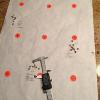What causes harmonics to be different one load to the next? First, the powder charge and it's "impact curve" going from rest to full burn. How the charge "rings" the barrel and starts the vibration node, it's amplitude, and then, the dwell time in the barrel where the bullet exits just as the muzzle comes to the most coaxial point in the vibration.
In a general sense, loading for more velocity eventually reaches a point where it "rings" the barrel harder and harder, which causes more dispersion. It's why handloaders working up loads note that they get the best accuracy with a charge under the safest maximum load. You can get more speed but it is usually at the cost of the group opening up.
Another element is just how far the bullet sticks out of the case and where it's positioned in relation to the rifling. As the bullet exits the mouth of the cartridge under increasing pressure, was it coaxial to the bore, does it stay coaxial, and does it travel in line to exit that way? Some ammo might be close enough in the box but that specific gun might be knocking it back slightly or causing the bullet to tip when loaded into a chamber - and that is why all self loading military ammo uses a crimp. That also brings up bullet setback, where it's not held tightly in the case mouth and gets shoved back compressing the powder charge.
It's complicated, is what it is.
So the bullet actually has to be straight in the bore to come out the muzzle straight, if it's tipped off axis it then gets a poor start. Then the muzzle has to actually be in line with the rest of the bore and not slightly offset from vibration.
Crooked bullets and a muzzle off target, big groups. We are talking tenths of a thousand and smaller dimensional variances, or changes of less than 50fps in velocity, or using one powder compared to another. Even adding a muzzle weight and it's position relative to the crown changes things, along with how hot the barrel is - they get more flexible when warmer.
It's been reported that pushing the bullet out just a few thousandths of an inch further out to engage the rifling can clean up a run of the mill group and make it to bragging rights turf.
It's why handloaders have so much fun!



